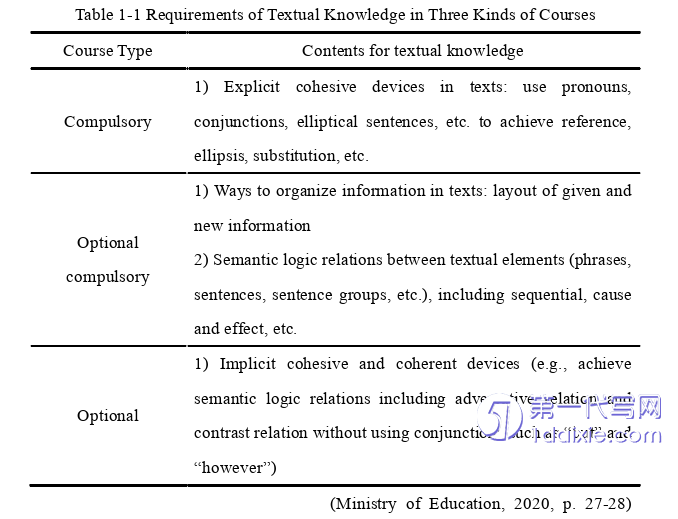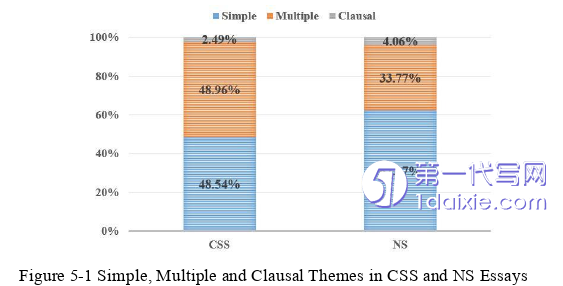本文是一篇英语论文,本文针对高中英语写作教学提出以下建议:首先,写作教学中应适当融入汉英思维差异的对比分析;其次,对范文的讲解和分析应关注语篇的文体特征;最后,教师可尝试将主位推进理论应用到写作教学中,开展显性的语篇连贯教学。
CHAPTER ONE INTRODUCTION
1.1 Research Background
Important as writing is, most English learners find it challenging to master. The difficulty lies in the need for a holistic grasp of both linguistic and textual knowledge. The former aims to improve accuracy at the local level, and the latter aims to promote coherence of the text at the global level. Nevertheless, the writing instruction together with assessment in senior high school has only haphazardly touched upon the textual level. Accordingly, how to write a coherent and fluent essay remains a considerable challenge for senior high school students.
Thematic structure, an essential method for discourse analysis, refers to the organization of information within individual clauses, and to the organization of the larger text through it (Xie, 2012). It plays a fundamental role in realizing text coherence and smooth communication. The appropriate arrangement of thematic structure can better achieve coherence compared with the utilization of cohesive devices. Hence, it is of great value for analyzing learners’ writing at the textual level, and contributes to improving learners’ textual knowledge and their writing competence.

1.2 Research Significance
The research significance of this study can be divided into two perspectives, including theoretical and practical significance.
1.2.1 Theoretical Significance
First, this study can better differentiate between the two concepts of cohesion and coherence. Cohesion and coherence are two highly correlated but different concepts in linguistics. Nevertheless, in some cases, they are mistakenly considered the same and used interchangeably. In regard to this, the study sorts out, summarizes, and compares the existing definitions of cohesion and coherence in order to better distinguish these two concepts from the theoretical perspective. Additionally, from the empirical perspective, as this study has incorporated thematic progression patterns and textual Theme into the writing analysis, it can further demonstrate that cohesion is a necessary but not a sufficient condition for coherence.
Second, this study can further verify and expand the applicability of Theme-Rheme theory in the field of discourse analysis. Previous research has managed to apply the Theme-Rheme theory to the discourse analysis of college English writing, academic writing, speeches, literary works, etc., with much attention paid to analyzing adult English learners’ writing. While in this study, the Theme-Rheme theory has been employed to analyze the textual features of compositions written by senior high school English learners. Hence, it contributes to extending the theory to the analysis of learners’ writing in basic English education and further confirming its effectiveness in discourse analysis.
CHAPTER TWO LITERATURE REVIEW
2.1 Definitions of Key Concepts
2.1.1 Theme and Rheme
The notion of Theme and Rheme was first put forward by Vilem Mathesius, the founder of the Prague school. He argues that Theme is, first, something known to both two parties or at least evident in the situation, which can be referred to as the given information; second, it serves as the basis of the discourse as well as what is being discussed in the clause (as cited in Danes, 1974, p. 106). Following the terminology of the Prague school of linguists, Halliday, one of the representatives of the Systemic-functional school, defined Theme as:
“... the element which serves as the point of departure of the message; it is that which locates and orients the clause within its context. And the remainder of the message, the part in which the Theme is developed, is called in Prague school terminology the Rheme” (Halliday, 2014, p. 89).
From the definition given by Mathesius, it can be noticed that the Theme-rheme structure is closely linked with the information structure. He claims that information in the Theme part is given while the information in the Rheme part is new. However, it is not always the case, and there should be a clear distinction between the Theme-rheme structure and Given-new information. Even though the placement of information is closely related to the thematic structure (Zhang & Miao, 2017), Theme-rheme structure and Given-new information are not the same. “The Theme is what ‘I’, the speaker chooses to take as ‘my’ point of departure for the utterance, while the Given is what ‘you’, the listener already knows about or has access to ‘you’” (Halliday, 1970, p. 299).
2.2 Relevant Studies at Home and Abroad
2.2.1 Studies on the Relationship Between T/TP and Coherence
Most of the research at home (Cheng, 2002; Chen, 2005; Lv, 2009; Ma, 2001) took the application of thematic progression theory into the analysis and evaluation of CET 4/6 or TEM 4/8 as an example so as to reveal the relationship between coherent English writing and T/TP patterns. For instance, Ma (2001) illustrated the relationship among the use of T/TP, cohesion, and coherence by analyzing three writing samples taken from CET-4 and CET-6. It was found that writings with higher grades were more coherent through choosing Themes within the same semantic field and adopting different types of thematic progression patterns. Cheng (2002) verified his hypothesis that one main reason for students’ incoherent English writing was their inappropriate and ineffective selection of thematic progression patterns after comparing the thematic progression patterns used in the original and revised version of students’ writings.
Studies have also been conducted abroad to corroborate the close relationship between T/TP and writing coherence. Mellos (2011) explored the correlation between writing coherence and thematic choices by analyzing the Theme-Rheme structure in eight undergraduate EFL learners’ essays with different coherence levels. Results revealed that essays with a high degree of coherence employed more topical Themes, textual Themes, and various thematic progression patterns, whereas essays with a low degree of coherence overused unmarked Themes and the constant Theme progression, which made the text difficult to understand. Chen (2019) examined the first draft and the published version of 20 medical research articles produced by Chinese doctoral students in order to track the changes in Theme choices and thematic progression patterns made in the revision process. Results showed that the majority of information discontinuity, represented by the frequent use of deviated thematic progressions, had been adjusted after revising and, thus, significantly increased the readability and coherence of the papers.
CHAPTER THREE THEORETICAL FRAMEWORK .................... 20
3.1 Three Metafunctions of Language ................................... 20
3.2 Halliday’s Categorization of Theme .......................... 20
CHAPTER FOUR RESEARCH METHODOLOGY ......................... 30
4.1 Research Questions ..................................... 30
4.2 Analytical Framework .................................... 31
CHAPTER FIVE RESULTS AND DISCUSSION .............................. 41
5.1 Overall Features of the Use of Theme in Senior High School Students’ Writing................ 41
5.1.1 Simple, Multiple, and Clausal Themes .............................. 41
5.1.2 Topical, Textual, and Interpersonal Themes ................. 43
CHAPTER FIVE RESULTS AND DISCUSSION
5.1 Overall Features of the Use of Theme in Senior High School Students’ Writing
5.1.1 Simple, Multiple, and Clausal Themes
Figure 5-1 reports the proportion of simple, multiple, and clausal Themes in CSS and NS essays. As shown in Figure 5-1, the most frequently used type by the CSS group was multiple Theme (48.96%), tightly followed by simple Theme (48.54%). It revealed their preference to add more elements that express textual and interpersonal meanings before the experiential element of a sentence. And the clausal Theme (2.49%) accounted for the lowest proportion, indicating that compound sentences were scarcely used in their writing. While in the NS group, the most frequently adopted type was simple Theme (62.17%), followed by multiple Theme (33.77%) and clausal Theme (4.06%).

Table 5-1 presents the independent samples t-test results of simple, multiple, and clausal Themes in CSS and NS essays. As demonstrated in Table 5-1, the CSS group (simple Theme: M=.4843, SD=.12713; clausal Theme: M=.0247, SD=.04881) used fewer simple Themes and clausal Themes than the NS group (simple Theme: M=.6249, SD=.06555; clausal Theme: M=.0400, SD=.03733). However, the mean score of multiple Theme in the CSS group (M=.4913, SD=12763) was much higher than that in the NS group (M=.3363, SD=.05600). Moreover, the differences between these two groups were all confirmed to be statistically significant in the use of simple Theme (t=-9.322, p=.000<0.01), multiple Theme (t=10.550, p=.000<0.01), and clausal Theme (t=-2.367, p=.019<0.05). The effect sizes for simple and multiple Theme were both very large (simple Theme: d=-1.390; multiple Theme: d=1.573), and that for clausal Theme was moderate (d=-.353).
CHAPTER SIX CONCLUSION
6.1 Major Findings
The major findings of this study can be summarized as follows. Finding 1 and finding 2 are concerned with the first research question.
Finding 3 aims to answer the second research question, and finding 4 corresponds with the third research question. Finding 1: Senior high school students show a consistent tendency with native speakers in the use of topical Theme. But meanwhile, they display distinct features from native speakers in the deployment of subsets of unmarked Themes and marked Themes.
According to the data analysis and discussion in Chapter 5, the mean score of topical Theme is the highest among all Theme types in both the CSS group (M=.6497) and NS group (M=.7040). In addition, the proportion of unmarked Theme (CSS:79.31%; NS:82.44%) in both groups far exceeds the proportion of marked Themes (CSS:20.69%; NS:17.56%), which contributes to the topic continuity of their essays. All these data apparently manifest that senior high school students have a consistent tendency with native speakers in the use of topical Theme as well as its subtypes.
However, despite the similarities, senior high school students also display certain distinct features from native speakers in the deployment of subsets of unmarked Themes and marked Themes, i.e., dummy subjects, personal pronouns, temporal and contingency adjuncts.
reference(omitted)
